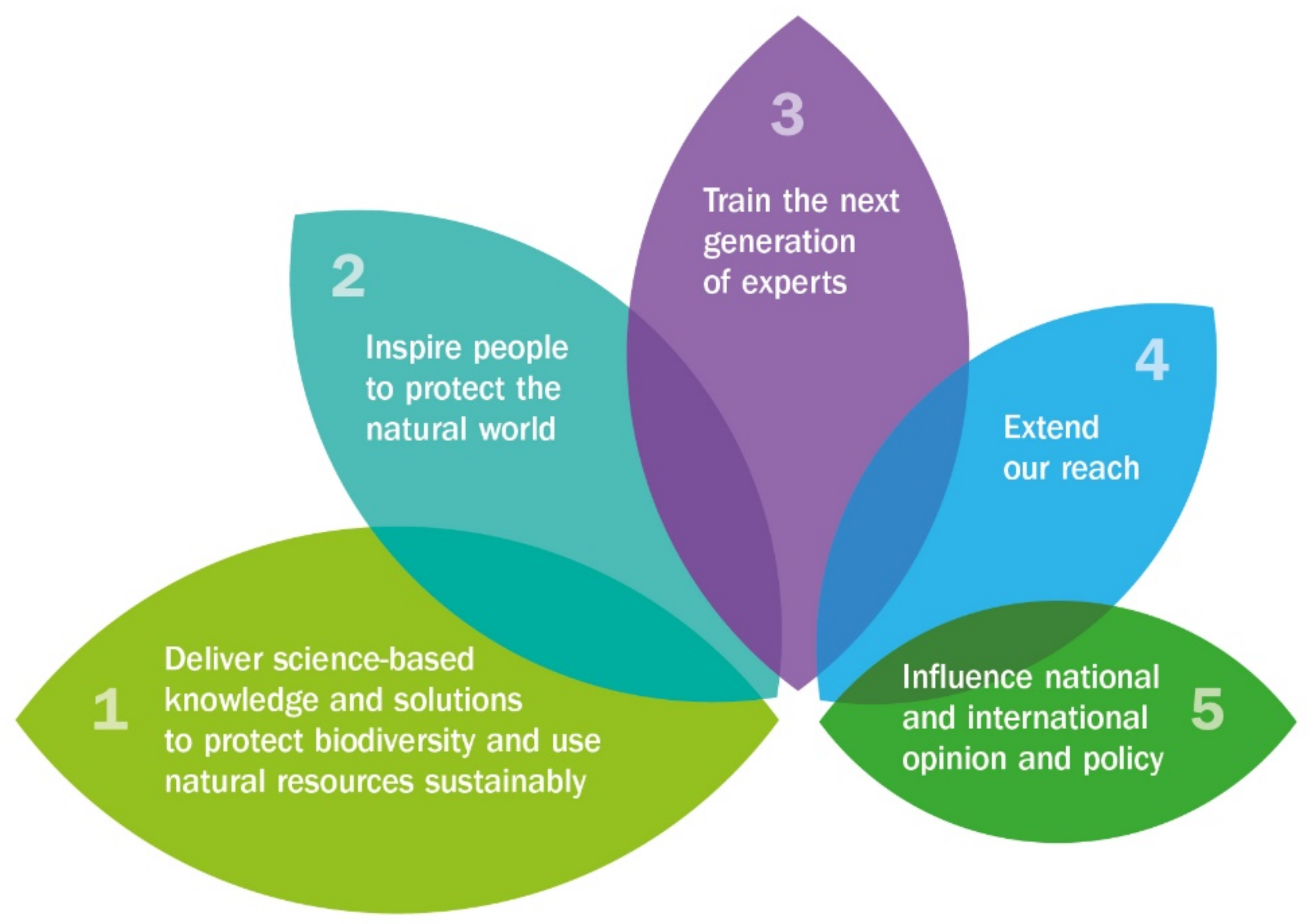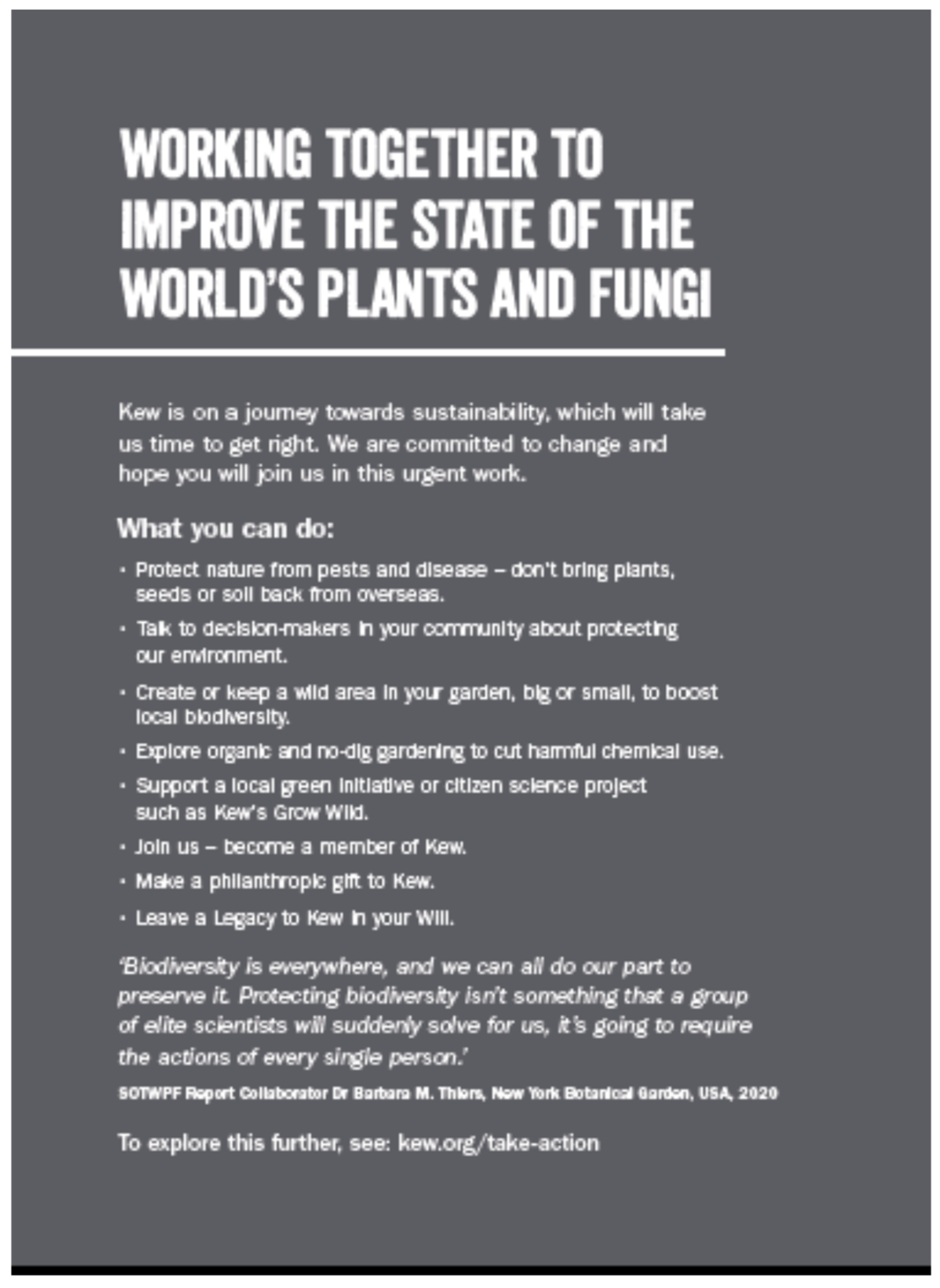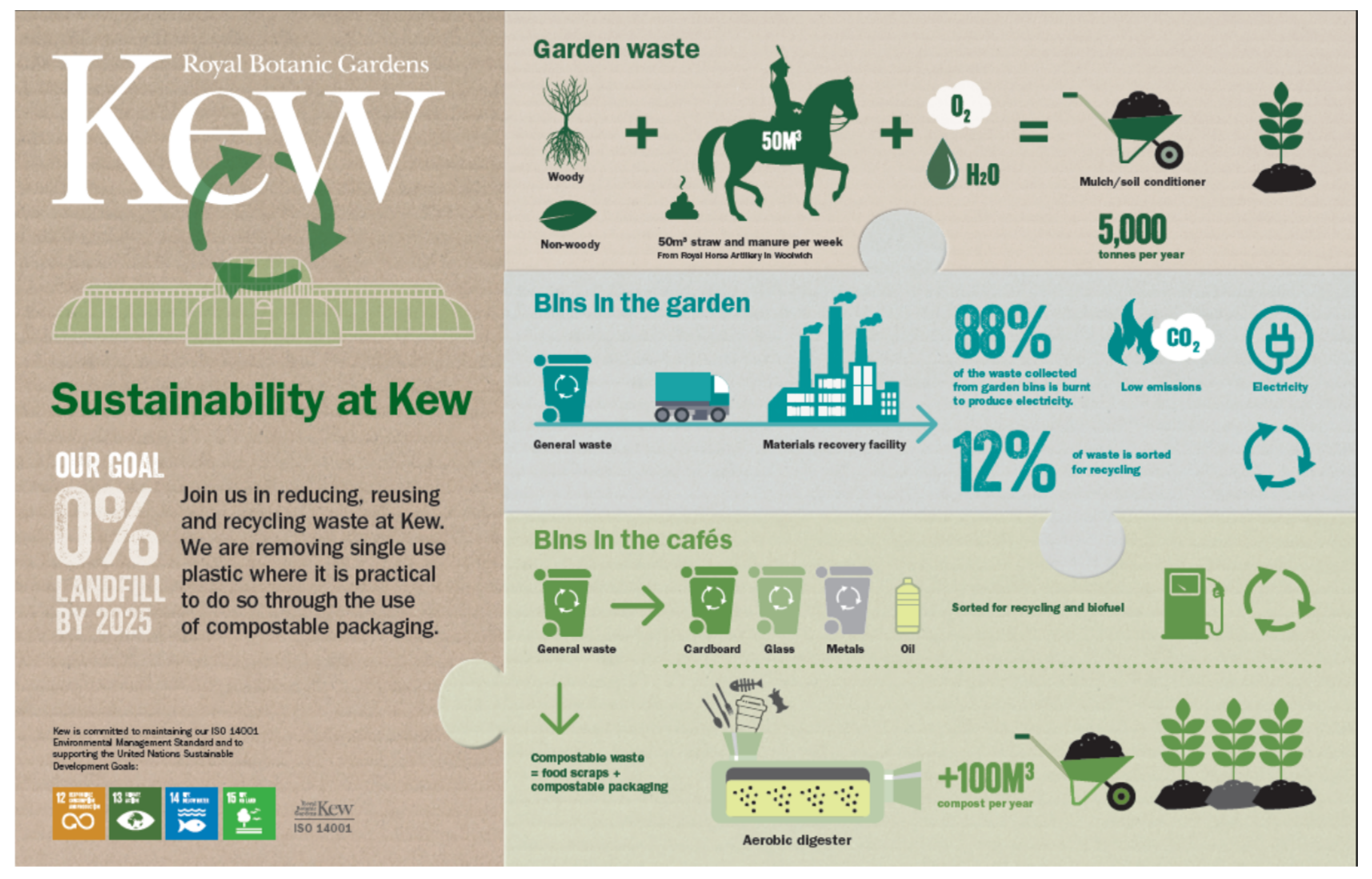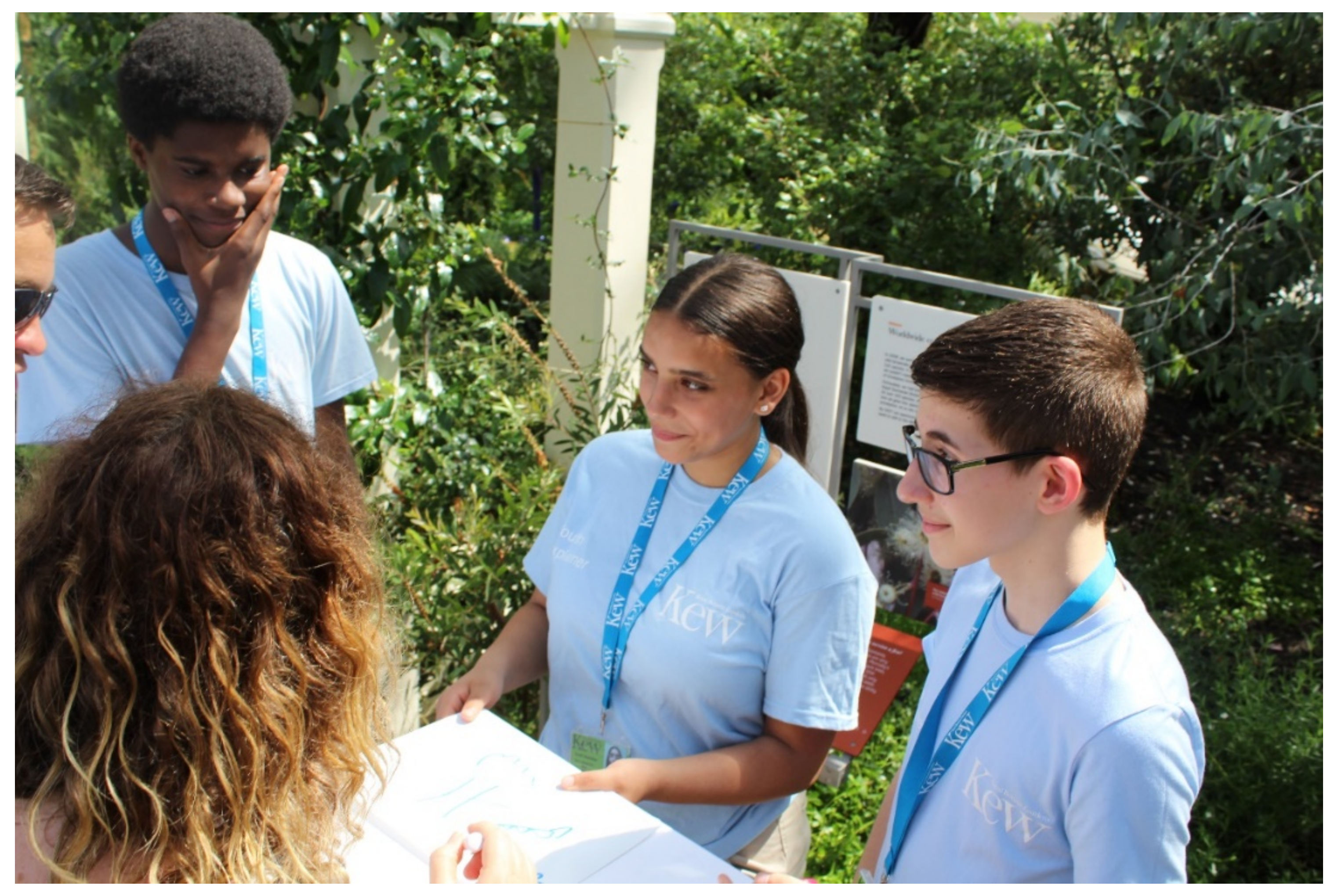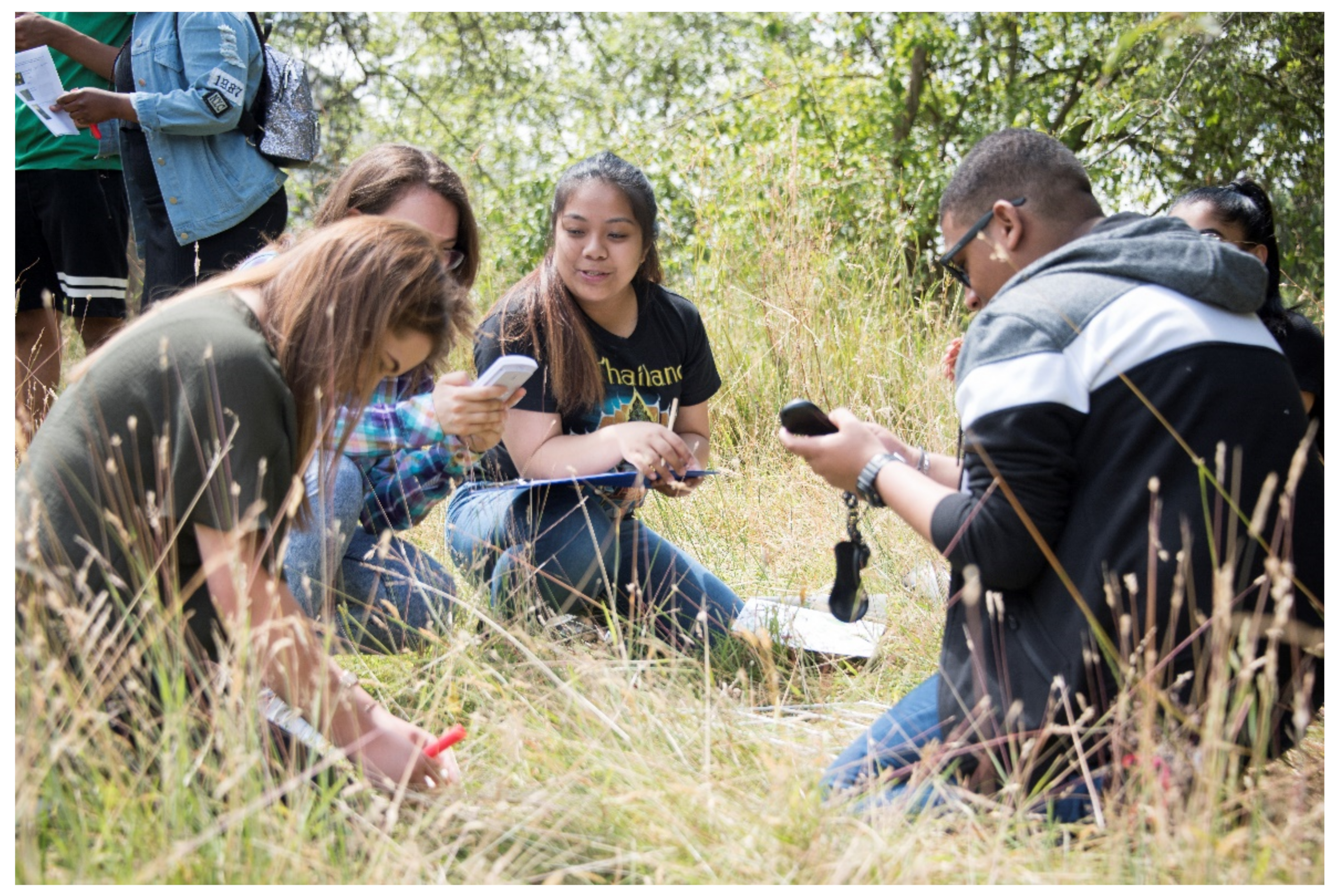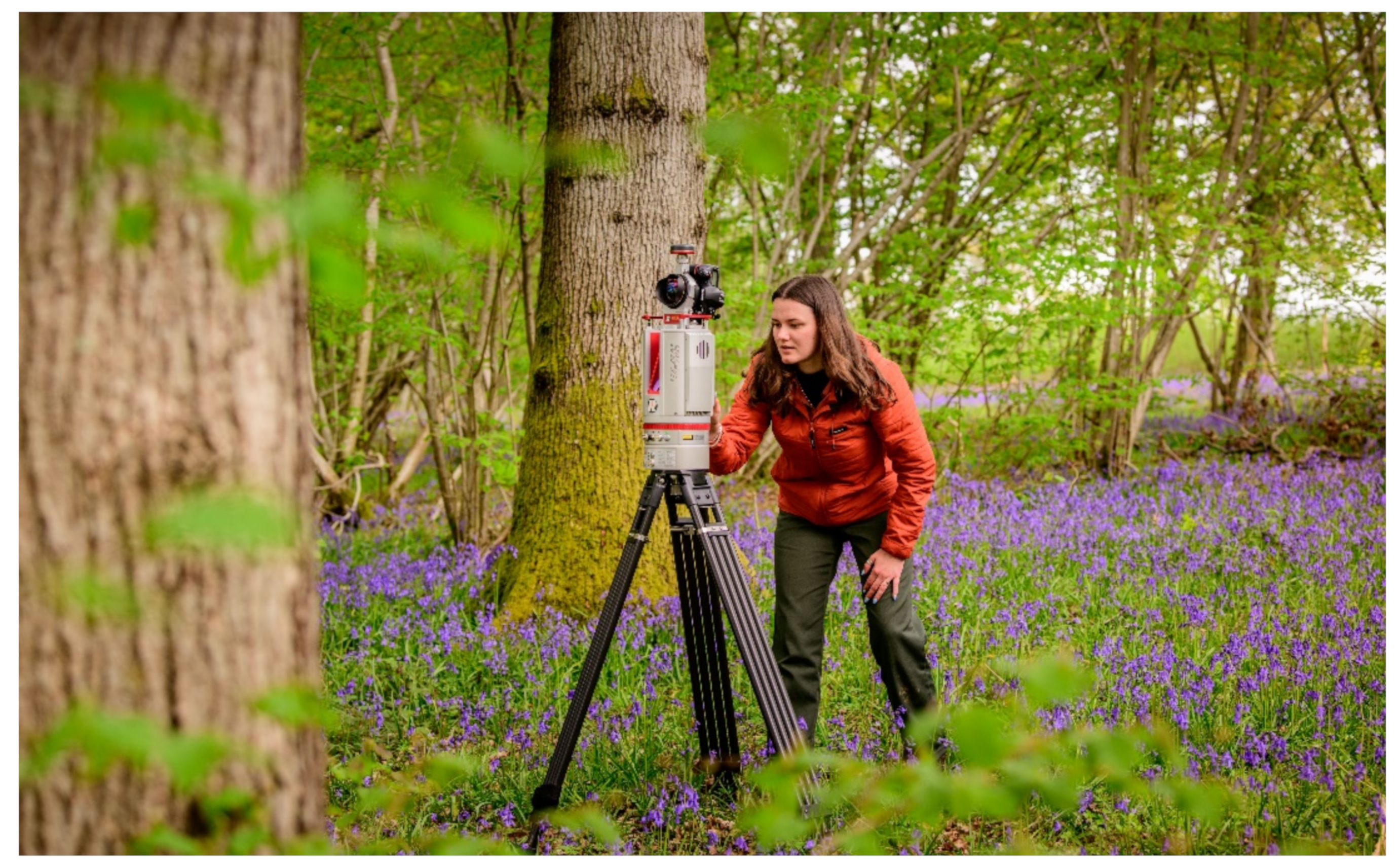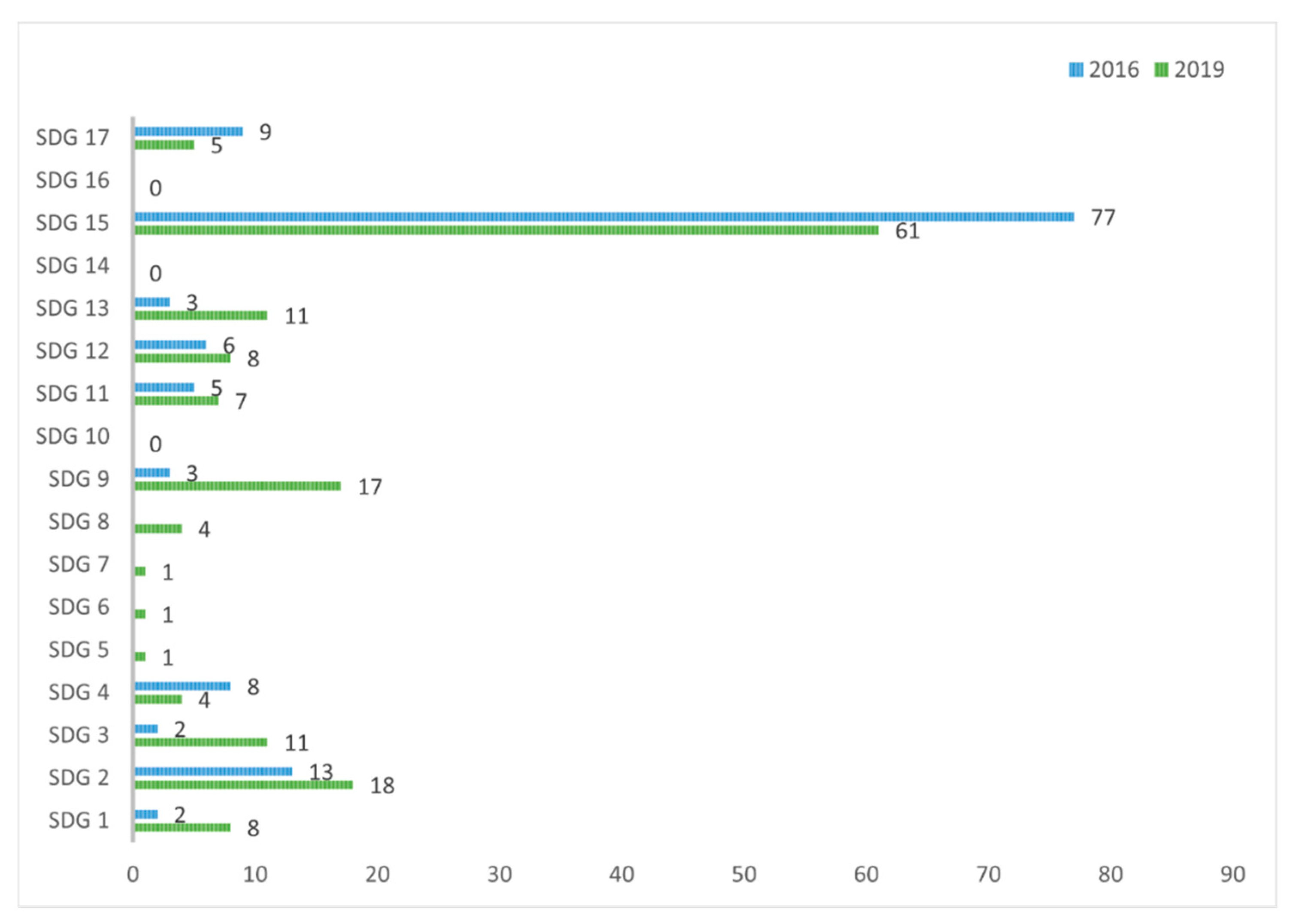1. Introduction
Biodiversity loss is commonly seen as a less evocative, emotive or immediate crisis than the climate emergency, which is higher up in the public consciousness, and has seemingly more tangible impacts, such as floods, droughts, fires, and climate migration. However, the impacts from this age of extinction will affect all aspects of life on Earth [
1]. These crises are connected in a vicious cycle—a changing climate drives further biodiversity loss, and degraded ecosystems are less able to absorb emissions and mitigate the worst consequences of climate change. Loss of biodiversity is known to be caused by a range of human-induced factors, including invasive alien species, fire, development impacts from agriculture, and urbanisation [
2], among others. According to the Millennium Ecosystem Assessment [
3] nearly all of our biodiversity has been significantly affected by human actions, and the greatest and fastest changes have taken place in the latter half of the twentieth century. Human development does not occur independently of the environment but exists in a system of mutual causality. The way that modern living, travel, trade, resource consumption, and waste generation collectively impact the planet’s biodiversity, has in turn devastating consequences for human health, disease and global pandemics, social equities, and poverty [
3]. Raising standards of living and societal development is undoubtedly a priority. However, doing so in a sustainable way that promotes mutually beneficial relationships with the environment is the only way to ensure equity, prevent future global health crises, and sustain essential ecosystem services that provide society with clean air, water, and resources for generations to come.
The Sustainable Development Goals (SDGs) are 17 goals designed and adopted by the United Nations in 2015 aimed at improving human well-being on a global scale. The SDGs have been described as the closest thing the world has to a plan at a time when an international strategy is more necessary than ever. They aim to reconcile economic, social, and ecological goals to address the multiple challenges faced for the sustainable development and continued existence of people on earth.
The 17 SDGs are intended to be achieved within this next decade and are written as calls to action, outlining some of the changes required to protect the planet and contribute to a sustainable future. The SDGs should not be viewed in isolation, but instead should be understood as influencing and interacting with each other, much as biodiversity loss is intertwined with climate change impacts. These interactions are critically important and are of interest and concern to botanic gardens. For example, to ensure that SDGs 1: No Poverty, 2: Zero Hunger, and 3: Good Health and well-being are achieved, SDG 15: Life on Land, must be addressed. Here botanic gardens can make a direct contribution through work on ecosystem assessment and metrics for monitoring biodiversity change.
What Are Botanic Gardens and Why Are They Important to the SDGs?
Traditionally, botanic gardens were seen as places where plants were studied and grown to increase our understanding and use of them—a practice that was disconnected from the context of global biodiversity loss, the ecosystems within which plants exist, and the services they provide for human well-being [
4]. Recently, botanic gardens worldwide have become more conservation-orientated, per the principles adopted by the International Agenda for Botanic Gardens in Conservation [
5,
6] and the Global Strategy for Plant Conservation (adopted at the Convention on Biological Diversity Conference of Parties VI, April 2002) [
7]. The result is that botanic gardens have changed; gardens are increasingly influential in social perceptions of humanity as a part of nature rather than separated, and as a means of communicating the critical importance of halting biodiversity loss. This has been achieved through recording the impacts upon biodiversity worldwide caused by climate change, the fragmentation and destruction of habitats, alien species, and overharvesting [
8]. Mitigation of these impacts is now a central goal of botanic gardens, achieved through the maintenance of collections (living and preserved), scientific research into the capacity of plants to provide new foods, medicines, fuels and resilient crops and ecosystems, the protection and restoration of plant species in the wild, and activities such as education and community engagement.
Botanic gardens are valuable cultural and natural assets, often enriched by high quality management and cherished by large external audiences. Layers of habitat, design and living collections combine into landscapes of structural and biological diversity, making them a significant research resource for ecosystem health.
The taxonomic and occasional genetic diversity of botanic garden living collections can offer informative indicators for future climate fitness and alternative sources of ecosystem services. The structural diversity, high levels of seasonal variation and sheltered environments create unique situations for researching the cultural services of botanic gardens, providing insights into the role these rich landscapes play in supporting physical and mental well-being.
This perspective on the value of botanic gardens as physical research sites reframes their scientific role. Impactful science can happen in arboreta, lawns and water gardens, alongside the more traditional venues of labs and glasshouses.
Often located in urban areas, botanic gardens are portals to nature, providing rich opportunities for a wide range of audiences to engage with them. Several gardens have programmes dedicated to encouraging underrepresented communities to connect with nature, who would otherwise be unable to. Botanic gardens are recognised as major players in the conservation and tourism sectors through their research and communication work, which keeps critical debates on biodiversity loss and human well-being at the forefront of media coverage.
The UN SDGs have the potential to assist botanic gardens in communicating their work with the public. However, a lack of awareness of conservation requirements and limited promulgation of the SDGs has resulted in little knowledge of the goals and how people can contribute towards achieving them. Consequently, those planning to use the SDGs must bridge this gap.
Relating the high-level SDGs at an individual scale is a challenge faced by every organisation. The UN Global Compact offers a measure of guidance for applying a selection of the SDGs, but not all. We must engage with an SDG framework which presents a quasi-Linnaean classification: each Goal is a genus, comprising various species of ‘Targets’, which in turn each have a number of sub-species of ‘Indicators’. Yet this uneven taxonomy offers a less than scientific methodology for implementing and measuring the SDGs.
Organisations have to work out for themselves how to use the SDGs. Approaches vary along a spectrum. At one end, many engage with the headline SDGs at a cursory level, scattering the coloured squares around their webpages, asserting a connection without detailing what it may be. At the opposite end, others seek rigour in the granularity of the Indicator metrics. However, the Indicators were drafted with low-income nations and their economies in mind, and are often inappropriate to UK entities. As an example, at face value, the Royal Botanic Gardens, Kew (Kew) clearly contributes to SDG 13 on Climate Action, but we are unable to demonstrate this by reference to the Indicators, which are simply not applicable to a botanic garden, such as ’13.1.1 Number of deaths, missing persons and persons affected by disaster per 100,000 people’ [
9].
We have concluded that the middle ground appears most feasible, as the sub-Goal Targets offer context to illustrate the intention of a particular SDG: this helps us relate the general principle of the SDGs to the specific practice of the work we do. The UN Global Compact and the UK Office for National Statistics both actively encourage the interrogation of the SDGs to implement them in a way that is meaningful for a particular organisation. A credible translation process requires effort and there is no universal template—particularly as botanic gardens are diverse organisations with varied subject matters and scopes of work. Reporting progress against the UN SDGs requires that continuous improvement takes place (such as improving interpretation of key conservation concepts or sharing cultural and heritage issues).
As a well-established garden with over 260 years of history, Kew has several directorates, all of which have an impact on one or more of the 17 SDG targets [
1]. These directorates and their constituent departments include horticulture, science, education, government affairs, and sustainability. Like the SDGs themselves, their work is intertwined. We aim to provide an overview and select case studies of how Kew works collaboratively to address the SDGs. This paper focuses on what Kew is doing to assist government and non-governmental organisations in halting biodiversity loss, inspiring and empowering diverse audiences to take action to tackle climate change and protect biodiversity, adopting internal sustainable practices, and promoting the needs of the environment—all of which contribute to the SDGs. Kew also works collaboratively with international partners towards shared objectives, and our work, like the SDGs, is thus both local and global in scope.
2. The SDGs in RBG Kew’s Strategies: Our Manifesto for Change and Science and Sustainability Strategies
The UN SDGs partly informed the development of Kew’s corporate strategy
, Our Manifesto for Change 2021–2030 [
10], which sets out the desired direction for the organisation over the next decade. Much of the work on the strategy was undertaken during the COVID pandemic, which highlighted the importance of understanding the fragility of our relationship with nature. The urgency of the biodiversity crisis, the visible impacts of climate change, and the deadline for the delivery of the UN’s Sustainable Development agenda by 2030 sharpened our focus as we developed the strategy, consulting internal and externally on the threats, opportunities, roles for Kew and the level of ambition we should strive for. As a plant science institution and botanic garden, we identified a space to work at the nexus of biodiversity, climate change, and sustainable development. We commit in the strategy to better ‘understanding and protecting plants and fungi for the well-being of people and the future of all life on Earth’ [
10] through five priority areas (
Figure 1). We see the SDGs as most pertinent to Priority 5.
Sustainable Development Goal 17 concerns partnership, which is at the heart of Kew’s strategy. Kew helps deliver the UK government’s commitment to the SDGs in our capacity as an arm’s length non-departmental public body of the Department for Environment, Food and Rural Affairs (Defra). Demonstrating our SDG contribution is equally valuable for other stakeholders and audiences, including donors and international partners. As a trusted brand both at home and overseas, with more than 300 plant scientists, unique collections and expertise, extensive public reach through our botanic garden, other sites and digital networks, and over 400 partnerships globally, we are increasingly being turned to for advice and opinions on the issues of the day. We anticipate this interest growing as 2030 approaches and pressure grows to reflect progress towards the SDGs. In Our Manifesto for Change, we commit to providing the scientific evidence to support decision-making across the board, to developing innovative science-based solutions to the challenges we face from climate change, and to shaping and informing policy and practice.
The SDGs reflect the interaction of the crises in biodiversity, climate change, and human health. This interconnectedness has been a focus of our engagement over the past year with UK, international governments, and intergovernmental organisations on the dual crises of biodiversity and climate change, the urgency with which we need to address both, and the role nature can play in providing solutions to improve climate, biodiversity, and development. With the Conferences of Parties (COPs) for both the UN Framework Convention on Climate Change (UNFCCC) and Convention on Biological Diversity (CBD) delayed from 2020 to 2021 and 2022 respectively, these COPs have featured prominently in our activities and planning.
As we write this paper, a cross-directorate delegation of Kew staff has just left the UNFCCC COP26. Kew was an official partner of the UNFCCC in Glasgow: one botanic garden and scientific institution amongst three US media giants, Google, Facebook and Bloomberg. Under this partnership, Kew was asked by the UNFCCC to provide a garden display for the UN Pavilion at COP26, which illustrated the science behind nature-based solutions (NbS) to climate change (
Figure 2) and the critical role nature will play in ensuring we reach net-zero by 2050. Beyond explaining carbon cycles and the concept of NbS, the posters and digital screen information explored our ‘Ten Golden Rules on Reforestation’ [
11], which seek to guide tree planting for carbon capture, biodiversity and livelihoods, as well as to recognise the importance of other biomes such as grasslands and protecting existing forests first. Beyond climate impacts, the display also illustrated Kew’s wider work on sustainable supply chains and agriculture to halt deforestation, support biodiversity, and provide benefits to local communities.
The SDGs formed the backdrop to further COP26 events at which we shaped discussions and influenced policymakers and other delegates. We organised a series of bilateral meetings with international and UK government officials, corporate representatives, and other prospective partners. We also hosted a series of panel discussions and VIP dinners, highlighting aspects of our role in addressing the biodiversity and climate crises, such as establishing the characteristics of ensuring climate-resilient crops for future food security and livelihoods, and innovations in measuring biodiversity as nature’s carbon storage to inform future initiatives. A common concern is to explore how we all maintain the momentum and interest in nature from COP26 to CBD COP15 and through this decade in order to support delivery of the SDGs. Scientists conducted many media interviews and this content was also shared widely with our networks and visiting public. The display from the UN’s Pavilion will be installed in the Temperate House at Kew for the remainder of 2021, so that our visitors can experience it.
Kew has made various contributions to the SDGs beyond COP26 in this first year of Our Manifesto for Change. We have contributed to international conventions and agreements such as the Convention on International Trade in Endangered Species of Wild Fauna and Flora (CITES), UN CBD and the UNFCCC. We have shared the expertise of our scientists and their knowledge and experiences of working on the ground. We have provided governments with various practical examples and lessons from our work mapping local biodiversity, including identifying areas for conservation; offering capacity building to ensure the next generations have the skills needed for future jobs; and contributing advice and tools to support green economic growth, such as databases of useful plant products. Our ambition is to amplify and build on this work over the next decade, to collaborate with a range of partners, and to do everything we can to combat climate change and biodiversity loss and contribute to the SDGs.
Kew’s aspiration to ‘end the extinction crisis and to help create a world where nature is protected, valued by all and managed sustainably’ is set out within our Manifesto. Further to this, our
Science Strategy 2021–2025 builds on how we will contribute to the SDGs through ecosystem stewardship, nature-based solutions, and unlocking the properties of plants and fungi for sustainable development [
12]; and our
Sustainability Strategy [
13] includes a series of commitments across three pathways to sustainability—using Kew’s action, expertise, and voice (
Figure 3).
The Sustainability Strategy links our commitments across these three pathways with the UN SDGs as a global framework for change. The headline Goals serve as a communication tool to connect local or organisational activities with global transformation.
Below the level of the Goals, however, things are a little less clear. For maximum clarity, transparency, and accountability, Kew’s initial instinct was to link the Sustainability Strategy to the SDGs by mapping our activities to the 169 targets that sit beneath the 17 headline Goals. However, such rigour is not possible because many of the SDG targets reflect nation-level progress and are simply not applicable at the level of any single organisation. In assessing how to engage with this challenge, we weighed the merits of using the SDGs:
Benefits of mapping organisational activities to the SDGs within Kew’s Sustainability Strategy
- √
Provides an inspiring framework to demonstrate the broad social, environmental and economic value of botanic gardens’ work.
- √
Places Kew’s actions in the context of national and international sustainable development needs, and government-level policies and programmes.
- √
Highlights the scale of sustainability challenges and opportunities, connecting on-the-ground change to the context of global transformation.
- √
Demonstrates the interdependence and connectivity between different areas of sustainability—bringing coherence to activities that can otherwise seem disparate and unconnected.
Challenges to mapping organisational activities to the SDGs within Kew’s Sustainability Strategy
- 🗴
Mapping activities to headline goals is not always seamless as it sometimes relies on some interpretation of the intention or direction of each Goal.
- 🗴
There is no standardised approach to integrating SDGs into organisational business planning or reporting organisational contribution towards the Goals.
- 🗴
The detailed targets are not written for organisations and are not fully comprehensive in covering the activities that support the Goals—reporting to target level would risk missing out activities that ‘fall between the gaps’.
- 🗴
Aligning and data-gathering against the Goals or targets can take significant resource, which could be better directed at delivery rather than reporting.
- 🗴
Some targets cannot be quantified, requiring qualitative reporting on progress, which reduces comparability across time and institutions.
- 🗴
Audiences’ perceived value of SDG reporting is impacted by the varying approaches taken by other organisations.
We have investigated several methodologies and have so far chosen to map Kew’s operational activities to headline goals but not targets. Our scientific projects may be easier to link to the more specific targets, as this work often has outputs which are more relevant to the internationally focused targets. We aim to continue to investigate methodologies to link our activities to the SDGs, and our thinking may change in future.
3. Calling Visitors to ‘Join Us’
In early 2020, staff from across Kew joined together with Executive Director Richard Deverell, Trustees and Critical Friends in a discussion about the need for our communications to develop a stronger voice around the twin crises of biodiversity loss and climate change. It was recognised within this forum that if Kew was to take a stronger position in communications, then we would need to develop strategies that empowered our visitors to take actions to meet these challenges within their daily lives.
‘Inspiration’ and ‘empowerment’ are important ideas to bear in mind when thinking about how to communicate about biodiversity loss and climate change. The main criticism levelled at traditional communications (including interpretation and education) around global change, centered on extinction or environmental loss, are the findings that this demotivates the intended audiences—“What can I do”, “This is all beyond me” or “I don’t have the power to fix this” [
14]. Framing these stories in a different way, linking to our love of the natural world, the beauty that can be found in nature, and the passion that our experts and visitors share for plants and fungi in the environment is the bridge to future change. Our role is to work with our audiences to build that bridge.
There is a subtle but important change in thinking and language here. This is about building and working together—a botanic garden is a powerful place sitting outside both academia and state, potentially a ‘third place’, as defined by Ray Oldenburg [
15]. Third places are public spaces that offer us common and fertile ground for sharing and generating conversations about difficult questions. Harnessing the power of the third place and focusing on the empowerment of our audiences came together with several other factors at play within Kew. As a result,
Our Manifesto for Change [
10] states a priority to ‘Inspire people to protect the natural world’ (
Figure 1). Additionally, the publishing of Kew’s first
Sustainability Strategy [
13], and work with the Botanic Gardens Conservation International (BGCI) on a Sustainability Challenge are aimed at influencing the behavior of 150 million visitors to botanic gardens worldwide.
In response to this, Kew established a ‘Calls to Action’ working group aimed at determining which specific actions or mitigations to biodiversity loss and climate change we could promote to our visitors. The working group was made up of staff from across Kew, representing science, communications, sustainability, and interpretation. The goal of this group was to generate a list of calls to action that could be added to any communications within the gardens and potentially online. Several parameters were used to guide the development of the calls to action (
Table 1).
We decided that, depending on the context of the communication, calls to action (
Table 1) from across this list might be used, or the focus could be on just a few or one. As an example, the first time the calls to action were used was in an agile interpretation of ‘
The State of the World’s Plants and Fungi 2020 Report’ [
2], the calls focused on were biodiversity, conservation. and working with us (
Figure 4).
Kew’s thinking on this project was strongly influenced by the UN SDGs (
Figure 5) and the presentation of this work via the
Lazy Person’s Guide to Saving the World [
16] and
Good Life Goals [
17].
Our challenges in this project have rested on deciding what our calls to action should be, working on how to build a stewardship model of delivering these calls (one that would involve our public in a more active engagement role with these ideas) and, finally, how to evaluate the impacts of this work. Behavioural change is challenging to achieve and complex to measure, and funds to complete this important part of the project continue to be elusive. Nevertheless, we continue to work towards our 2030 vision that: Every visitor and partner has a strong sense of how they can join us in fighting for a sustainable world.
4. Learning to Achieve the UN Sustainable Development Goals
We want Kew to be the go-to place for everyone to explore how plants and fungi add value to their lives and, for this reason, ‘Extend our Reach’ is one of the five priorities in our
Manifesto (
Figure 1) [
10]. Through our learning programmes, Kew contributes to the delivery of several of the Global Goals and targets, namely: SDGs 4, 11, 12, and 13.
SDG 4 is about inclusive and quality education for all, and we recognise the need to share our knowledge and collections both physically and digitally with everyone. Kew Gardens, our main site, is in Greater London, in which 28% of the population lives in poverty (2.5 million people). Around two-fifths of people from ethnic minority groups live in low-income households—twice the proportion of white people [
18]. Those on lower incomes are also more likely to experience poorer physical health and mental health conditions, and poverty rates are known to increase in single parent households and/or when families have a disabled member [
19].
To address this, we operate a Community Access Scheme providing substantially discounted entry for groups facing social, economic, physical or psychological barriers. We also organise an annual free Community Open Week for communities across London (
Figure 6), offer bursaries to schools in disadvantaged areas, and target low-income groups to engage with.
All learning programmes are linked to Kew’s work in plant and fungal science and biodiversity conservation, and participants are encouraged to reflect on their lifestyles in line with sustainable development (SDG4, 11, 12 and 13). Scientific literacy is essential if people are to understand biodiversity loss and climate change and, for this reason, our approach to learning involves connecting people to nature and encouraging the development of science capital, which involves building knowledge, attitudes, experiences, and social contacts. Research shows that the greater the science capital people have, the more likely they are to engage in science and see it as relevant to their lives [
20]. This in turn can provide a route to social mobility.
A good example of this is our Youth Explainer Programme, now in its fourth year. The programme gives young people between the ages of 14 and 17 the opportunity to develop their knowledge and skills in science and communication, and to volunteer as Explainers at the Kew Gardens site (
Figure 7). Young people undertake six months of training and engage with a range of experts, including Kew scientists. Through working in groups, they develop interactive games (from concept through to fully designed item) that bring to life stories of rare and endangered plants. Each year, approximately 25 participants are chosen by their teacher as students who would particularly benefit from taking part, and many express their desire to study science further.
“I didn’t really know anything about all this plant science stuff. It was quite interesting to me, I was surprised how much I liked it. It’s kind of inspiring. It’s made me think that perhaps I would enjoy more science at school and that I might try to go in that direction, even at college or Uni.”
Youth Explainer
Through our schools programme, we engage with approximately 100,000 pupils on site each year, and with around 140,000 pupils online on our learning platform, ‘Endeavour’. Sessions on site are based on inquiry-based learning, supporting pupils to observe, question and investigate real-world science concepts that are difficult, if not impossible, to replicate in school (
Figure 8). For example, exploring the essential services rainforests provide and looking at how human activity is shaping and affecting these diverse ecosystems. Online, one of the challenges we offer invites pupils to design and complete plant health surveys to investigate the devastating effect the ash dieback fungus (
Hymenoscyphys fraxineus) is having on local tree populations [
21,
22], a project that contributes to SDG 15.
Kew’s commitment to Extend our Reach also includes our national outreach learning programme, Grow Wild. Grow Wild inspires people to take positive actions for UK native plants and fungi, and since 2013 we have shared enough seed for 2.4 million people to cover 714 hectares with wildflowers. Grow Wild has also distributed almost £1 million in project grants to 258 young people and 344 community groups, with 48% of projects located in 30% of the most deprived areas of the UK.
6. Conclusions
At the core of Kew’s work is our ambition to stop the extinction crisis and tackle the climate emergency—and in doing so to support the interwoven SDGs to protect the biosphere for the benefit of society and the economy. We have shown that through constructive stakeholder and community participation and interaction in mutually beneficial programmes and projects, SDGs 2, 4, and 5 are actioned. Collaboration (internally and externally) is key to meeting the sustainable development agenda, from empowering visitors, schools, and communities when they visit our botanic gardens, to research collaborators. Our research projects show that through sustainable community-based, socio-economic initiatives, biodiversity loss is better understood and halted. The data from botanic garden collections and research have assisted with improved species lists, increasing distribution data on key species, and improved assessments of biodiversity loss [
2]. They provide for the much-needed Red List assessments of species enabling establishment of local and international conservation legislation, prioritization of targets, and strategic planning for the future. This work contributes to many of the targets within the Global Goals but particularly addresses SDGs 1, 2, 3, 4, 9, 13, 15, and 17. However, this is by virtue of the fact that the work we do aligns with the SDGs rather than dedicated work towards achieving exact targets within the Global Goals.
Together with the support of BGCI, we aim for a greater understanding of how to effectively implement the call to action that the 17 Global Goals make. Urgent action is required to tackle the environmental emergency—the SDGs can support this as a useful communication and engagement framework. They link on-the-ground actions with global change and interwoven challenges that require broad engagement. Kew is exploring opportunities to further engage with the SDGs by addressing formal environmental education and non-formal (issue-based) topics through which we can raise awareness about the importance of biodiversity in both individuals and communities. Through enhanced visitor experiences within the gardens at Kew, we can provide a central point for conservation ideas and examples.
We have concluded that the middle ground appears most feasible as the Targets offer context to illustrate the intention of a particular SDG: this helps us relate the general principle of the SDGs to the specific practice of the work we do. The interpretation of the SDG framework approved by both the UN Global Compact and the UK Office for National Statistics actively encourages the interrogation of the SDGs in order to implement them in a way that is meaningful for a particular organization.
Our next step is to begin that process. We are considering working with teams across Kew on a two-way assessment, examining a) the relevance of the Goals to us, by assessing the applicability to our core activities of each SDG, as informed by the subsidiary Targets; and b) our contribution to the SDGs, to make a meaningful impact on those individual SDGs.
We recognise the challenges presented by the SDGs and anticipate that this will be an iterative process. We also aim to link SDG reporting into Kew’s annual reports and accounts—this is likely to be at headline Goal level, as a rigorous reporting process that goes beyond the headline Goals (e.g., mapping activities against targets) would require significant resources to develop. We are working with other parts of government to align to SDG reporting frameworks that are being developed elsewhere, and upskilling Kew staff to understand the ways in which their work supports or links to SDGs (training, workshops etc.). Our aim is to use the SDGs as an internal and external sustainability engagement tool.
An ultimate objective of the SDGs is to halt the current and future loss of plant diversity. As a signatory to the GSPC and UN SDG policy frameworks, Kew sees the need to establish many programmes across its estate working on halting biodiversity loss and its associated impacts (poverty, inequality, etc.). Many of these projects or programmes already exist within Kew; their aims require adjusting to meet the new conservation targets and new programmes established. Our paper highlights the benefit of botanic gardens in promoting sustainability and a positive relationship with nature for all, bringing us closer to achieving the Global Goals by 2030.
